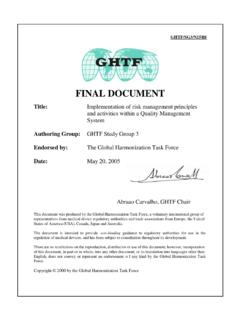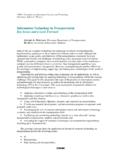Transcription of INFORMATION TECHNOLOGY FOR DISASTER …
1 Proceedings of National Conference; INDIACom-2007 Computing for Nation Development, February 23 24, 2007 Bharati Vidyapeeth University Institute of Computer Applications and Management, New Delhi. INFORMATION TECHNOLOGY FOR DISASTER MANAGEMENT Tulsi Vyas Aneri Desai ABSTRACT Now in the age of TECHNOLOGY it has been easier to manage the disasters both natural and men made. We can manage them by using the various features of INFORMATION TECHNOLOGY . IT is useful to prevent as well as recover It may be observed that advancement in INFORMATION TECHNOLOGY in the form of Internet, GIS, Remote Sensing, satellite communication, etc. can help a great deal in planning and implementation of hazards reduction measures.
2 GIS can improve the quality and power of analysis of natural hazards assessments, guide development activities and assist planners in the selection of lessening measures and in the implementation of emergency preparedness and response action. Remote Sensing, on the other hand, as a tool can very effectively contribute towards identification of hazardous areas, monitor the planet for its changes on a real time basis and give early warning to many impending disasters. Communication satellites have become vital for providing emergency communication and timely relief measures. Integration of space TECHNOLOGY inputs into natural DISASTER monitoring and mitigation mechanisms is critical for hazard reduction.
3 It is absolutely necessary to create awareness amongst the public as well as decision makers for allocating resources for appropriate investments in INFORMATION TECHNOLOGY . In this paper an attempt has been made to highlight the role of INFORMATION TECHNOLOGY in management of natural disasters in India Key words Disasters in India Application of IT in DISASTER Management Warning and Forecasting System Financial and Administrative Arrangements Administrative Structure INTRODUCTION It is a well known fact that natural disasters strikes countries, both developed and developing, causing huge destruction and creating human sufferings and producing negative impacts on national economies.
4 Due to various geo-climatic conditions prevalent in different parts of the globe, different types of natural disasters like floods, droughts, earthquakes, cyclones, landslides, volcanoes, etc. strikes according to the vulnerability of the area. India is considered as the world's most DISASTER prone country. It has witnessed devastating natural disasters in recent past like droughts, floods, cyclones, earthquakes, NATURAL DISASTERS IN INDIA India is a large country and prone to a number of natural hazards. Among all the natural disasters that country faces, river floods are the most frequent and often devastating. The shortfall in the rainfall causes droughts or drought like stimuli in various parts of the country.
5 The country has faced some severe earthquakes causing widespread damage to the life and property. India has a coastline of about 8000 km which is prone to very severe cyclonic formations in the Arabian Sea and Bay of Bengal. Another major problem faced by the country is in the form of landslides and avalanches. With an increase in the perception towards spreading a culture of prevention in the DISASTER management scenario, considerable emphasis is now being placed on research and development activities in the area of INFORMATION TECHNOLOGY for DISASTER preparedness and prevention. This has Copy Right INDIACom 2007 1 Proceedings of National Conference; INDIACom-2007 brought in a significant positive change even though the multitude and frequency of disasters in the country has increased.
6 APPLICATION OF INFORMATION TECHNOLOGY IN DISASTER MANAGEMENT Though it is not possible to completely avoid the natural disasters, but the sufferings can be minimized by creating proper awareness of the likely disasters and its impact by developing a suitable warning system, DISASTER preparedness and management of disasters through application of INFORMATION TECHNOLOGY tools. The changing trends have opened up a large number of scientific and technological resources and skills to reduce DISASTER risk. There are mainly applications we can use to manage disasters: 1) GIS and Remote Sensing 2) Internet GIS AND REMOTE SENSING GIS provides a tool for effective and efficient storage and manipulation of remotely sensed data and other spatial and non-spatial data types for both scientific management and policy oriented INFORMATION .
7 This can be used to facilitate measurement, mapping, monitoring and modelling of variety of data types related to natural phenomenon. The specific GIS application in the field of Risk Assessment are:- Hazard Mapping to show earthquake, landslides, floods or fire hazards. Theses map could be created for cities, districts or even for the entire country and tropical cyclone Threat Maps are used by meteorological departments to improve the quality of the tropical storm warning services and quickly communicate the risk to the people likely to get affected by the cyclone. Remote sensing makes observation of any object from a distance and without coming into actual contact.
8 Remote sensing can gather data much faster than ground based observation, can cover large area at one time to give a synoptic view. Remote sensing comprises Aerial Remote Sensing which is the process of recording INFORMATION , such as photographs and images from sensor on aircrafts and Satellite Remote Sensing which consists of several satellite remote sensing system which can be used to integrate natural hazard assessments into development planning studies. These are: Land sat, SPOT Satellite, Satellite Radar System, Advanced Very High Resolution Radio. Some applications of GIS and Remote Sensing in various disasters are as follows:- (A)DROUGHT GIS and Remote Sensing can be used in drought relief management such as early warnings of drought conditions will help to plan out the strategies to organize relief work.
9 Satellite data may be used to target potential ground water sites for taking up well-digging programmers. Satellite data provides valuable tools for evaluating areas subject to desertification. Film transparencies, photographs and digital data can be used for the purpose of locating, assessing and monitoring deterioration of natural conditions in a given area. (B)EARTHQUAKE GIS and Remote Sensing can be used for preparing seismic hazards maps in order to assess the exact nature of risks. (C)FLOODS Satellite data can be effectively used for mapping and monitoring the flood inundated areas, flood damage assessment, flood hazard zoning and post-flood survey of rivers configuration and protection works.
10 (D)LANDSLIDES Landslide zonation map comprise a map demarcating the stretches or area of varying degree Copy Right INDIACom 2007 2 INFORMATION TECHNOLOGY FOR DISASER MANAGEMENT of anticipated slope stability or instability. The map has an inbuilt element of forecasting and is hence of probabilistic nature. Depending upon the methodology adopted and the comprehensiveness of the input data used, a landslide hazard zonation map able to provide help concerning location,-extent of the slop area likely to be affected, and rate of mass movement of the slope mass. (E)SEARCH AND RESCUE GIS can be used in carrying out search and rescue operations in a more effective manner by identifying areas that are disasters prone and zoning them accordingly to risk magnitudes.




